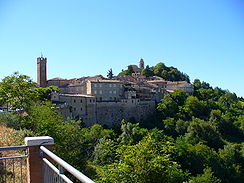
Peter of Farfa
Encyclopedia
Peter was the long-serving Abbot of Farfa from about 890 until his death, replacing the interim abbot Vitalis
. His abbacy marked the end of a confused period which saw four abbots in the space of two years.
 In 897 Farfa was attacked by Saracens and the words of a later abbot found "the properties of our monastery, which were given mercifully by the pious, dispersed cruelly by the impious [through] evil destruction". The history of this and subsequent events is recorded in the Destructio monasterii Farfensis written by the early eleventh-century abbot Hugh
In 897 Farfa was attacked by Saracens and the words of a later abbot found "the properties of our monastery, which were given mercifully by the pious, dispersed cruelly by the impious [through] evil destruction". The history of this and subsequent events is recorded in the Destructio monasterii Farfensis written by the early eleventh-century abbot Hugh
, whose wording allows that some of the raiders were locals and not Saracens, who had begun to settle in south and central Italy and systematically plunder the countryside
. The abbey buildings were used as a barracks at first, but in 898 they were accidentally burnt down.
The monks of Farfa, under Peter's direction, fled, some to Rome
and others to Rieti
. The abbey's treasures followed them, but its library and archive were brought by Abbot Peter and a few others to the church of Saint Hippolytus in Fermo
. He soon had them moved again to the castle of Santa Vittoria in Monte Matenano
. Much of the loss of documents recorded by Gregory of Catino
in the late eleventh century probably occurred during this itinerant period. Gregory's Chronicon Farfense, a chronicle
, relies in part on Hugh's work, but he mentions the archival limitations (incompleteness and sometimes illegibility) in his Regestum Farfense, a cartulary. The books and documents did not return to Farfa until around 930.
Vitalis of Farfa
Vitalis was the "surrogate" Abbot of Farfa in 888, between the death of Spento and the election of the long-serving Peter. The history of the period in Farfa's history, besides the barest chronological outline, has been obscure since it was first written down, by Gregory of Catino in the late...
. His abbacy marked the end of a confused period which saw four abbots in the space of two years.

Hugh of Farfa
Hugh was the Abbot of Farfa from 998. He founded the abbatial school and wrote its history from the late ninth through the early eleventh century under the title Destructio monasterii Farfensis...
, whose wording allows that some of the raiders were locals and not Saracens, who had begun to settle in south and central Italy and systematically plunder the countryside
History of Islam in southern Italy
The history of Islam in southern Italy begins with the Islamic conquest and subsequent rule of Sicily and Malta, a process that started in the 9th century. Islamic rule over Sicily was effective from 902, and the complete rule of the island lasted from 965 until 1061...
. The abbey buildings were used as a barracks at first, but in 898 they were accidentally burnt down.
The monks of Farfa, under Peter's direction, fled, some to Rome
Rome
Rome is the capital of Italy and the country's largest and most populated city and comune, with over 2.7 million residents in . The city is located in the central-western portion of the Italian Peninsula, on the Tiber River within the Lazio region of Italy.Rome's history spans two and a half...
and others to Rieti
Rieti
Rieti is a city and comune in Lazio, central Italy, with a population of c. 47,700. It is the capital of province of Rieti.The town centre rests on a small hilltop, commanding a wide plain at the southern edge of an ancient lake. The area is now the fertile basin of the Velino River...
. The abbey's treasures followed them, but its library and archive were brought by Abbot Peter and a few others to the church of Saint Hippolytus in Fermo
Fermo
Fermo is a town and comune of the Marche, Italy, in the Province of Fermo.Fermo is located on a hill, the Sabulo with a fine view, on a branch from Porto San Giorgio on the Adriatic coast railway....
. He soon had them moved again to the castle of Santa Vittoria in Monte Matenano
Santa Vittoria in Matenano
Santa Vittoria in Matenano is a comune in the Province of Fermo in the Italian region Marche, located about 70 km south of Ancona and about 20 km northwest of Ascoli Piceno....
. Much of the loss of documents recorded by Gregory of Catino
Gregory of Catino
Gregory of Catino was a monk of the Abbey of Farfa and "one of the most accomplished monastic historians of his age." Gregory died shortly after 1130, possibly in 1133....
in the late eleventh century probably occurred during this itinerant period. Gregory's Chronicon Farfense, a chronicle
Chronicle
Generally a chronicle is a historical account of facts and events ranged in chronological order, as in a time line. Typically, equal weight is given for historically important events and local events, the purpose being the recording of events that occurred, seen from the perspective of the...
, relies in part on Hugh's work, but he mentions the archival limitations (incompleteness and sometimes illegibility) in his Regestum Farfense, a cartulary. The books and documents did not return to Farfa until around 930.

